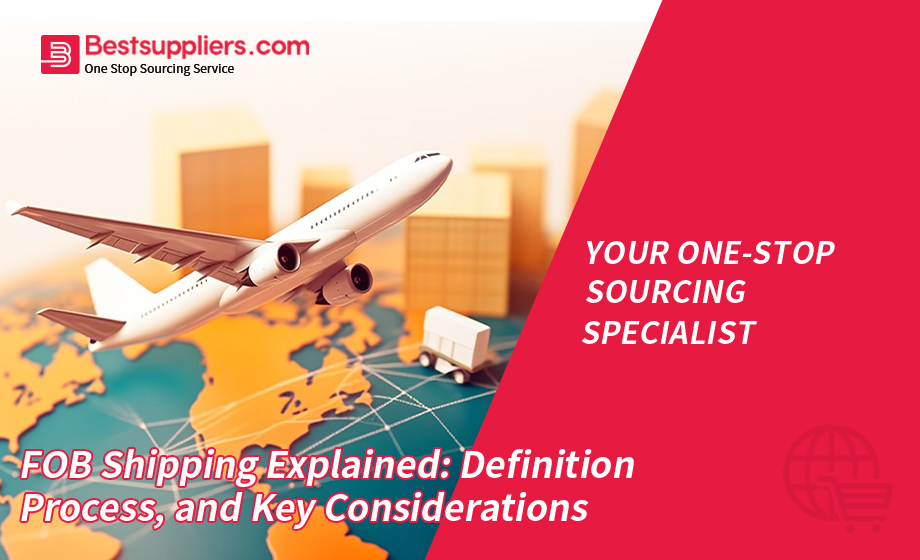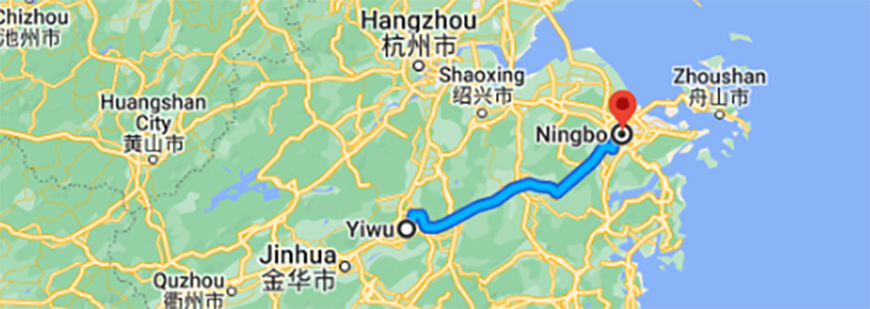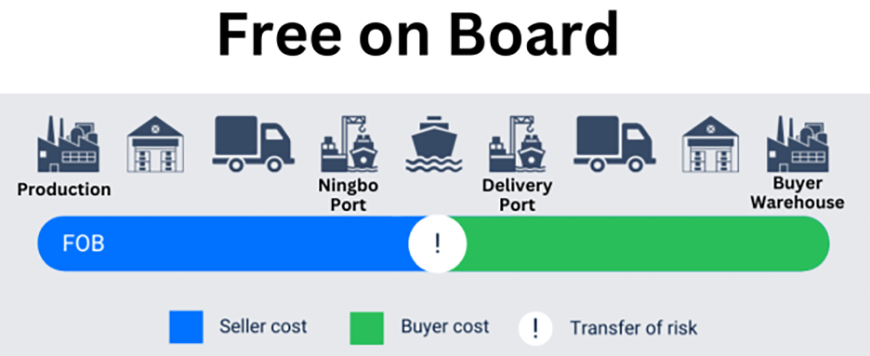FOB Shipping Explained: Definition, Process, and Key Considerations

Introduction:
In the realm of international trade, understanding the intricacies of shipping terms is crucial for businesses engaged in importing and exporting goods. One such term that holds significant importance is FOB shipping, which stands for "Free on Board." FOB shipping defines the transfer of responsibilities and risks between the buyer and the seller at a specific point during the transportation process. This article serves as a comprehensive guide to FOB shipping, providing insights into its definition, process, pricing, advantages, and differences from other shipping terms. By delving into the nuances of FOB shipping, businesses can gain a deeper understanding of its implications and make informed decisions to optimize their import transactions, particularly when dealing with goods from China.
FOB Shipping: Understanding the Concept and Its Implications:
FOB shipping, short for "Free on Board," plays a fundamental role in the realm of global trade, defining the obligations of sellers and buyers. When a transaction is governed by FOB shipping, the seller undertakes the responsibility of delivering the goods to a predetermined port within their country. Once the goods arrive at the designated port, ownership and risk are promptly transferred to the buyer.
To illustrate this concept further, let's consider an example involving an American seller, ABC Electronics, and a Brazilian buyer, XYZ Retail. Suppose ABC Electronics agrees to a FOB shipping arrangement. In this case, ABC Electronics would be responsible for arranging and overseeing the transportation of the goods from their facility to the designated port in the United States. Once the goods are successfully loaded onto the vessel bound for Brazil, the ownership and risk associated with the shipment shift to XYZ Retail. Consequently, XYZ Retail assumes the responsibility for any potential costs, such as freight charges, insurance, and customs duties, as well as any risks linked to the transportation process, such as loss or damage
.In conclusion, FOB shipping, or "Free on Board," defines a contractual agreement wherein the seller bears the responsibility of delivering goods to a specific port within their country. Once the goods reach the designated port, the buyer assumes ownership and the associated risks. This arrangement necessitates the buyer to manage all subsequent costs and risks throughout the transportation process. By understanding the implications of FOB shipping, businesses can make informed decisions when engaging in international trade transactions.
FOB Shipping Process:
Let's delve into the intricacies of the FOB shipping process by examining a practical case. Suppose you, as a buyer, are importing 20,000 glasses from a Chinese supplier located in Yiwu, China. The goods are to be shipped to the Port of Ningbo and then delivered to your desired destination. Within this context, the FOB shipping terms clearly define the roles and responsibilities of both parties involved.
Seller's Responsibilities:
As the seller, your primary responsibilities encompass several crucial tasks. Firstly, you are accountable for appropriately packaging the goods to ensure their safe transport. Additionally, you are responsible for arranging and overseeing the transportation of the packaged goods to the Port of Ningbo.

This entails engaging a reputable freight forwarder or logistics provider to handle the shipment process efficiently. Furthermore, you must handle the export declaration, ensuring compliance with all relevant regulations and requirements. Throughout this process, you bear the costs associated with packaging, transportation to the port, and the export declaration. Notably, any damages incurred to the goods before their loading onto the vessel at Ningbo Port are your liability, and you are required to provide appropriate compensation.
Buyer's Responsibilities:
As the buyer, you have specific responsibilities that come into effect once the goods are loaded onto the vessel at the Port of Ningbo. Your first task involves engaging a competent freight forwarder who will assist you in managing the subsequent stages of the shipping process. This freight forwarder can be a trusted partner or a professional recommended by the seller. Once the goods are in your possession, you assume ownership and bear the associated responsibilities.

These responsibilities include arranging transportation from the port to your designated destination, covering the shipping costs payable to the freight forwarder, and managing the necessary import customs clearance procedures. Additionally, as the buyer, you must assume the risks of any potential damage or loss that may occur during transit. To mitigate these risks effectively, it is advisable to obtain cargo insurance, providing financial protection against unforeseen circumstances that may lead to damage or loss of the goods.
In summary, FOB shipping involves a clearly defined set of responsibilities for both the buyer and the seller. The seller's obligations encompass packaging, transportation to the port, export declaration, and liability for any pre-loading damages. On the other hand, the buyer's responsibilities commence upon the goods' loading onto the vessel and include arranging transportation, paying shipping costs, managing import customs clearance, and assuming the risks associated with transit. By comprehending and fulfilling their respective roles within the FOB shipping process, buyers and sellers can navigate international trade transactions smoothly and efficiently.
FOB Shipping Point vs. FOB Shipping Destination:
When exploring FOB shipping, you may encounter the terms FOB shipping point and FOB shipping destination. However, it is important to note that these distinctions are not commonly utilized in import transactions from China, where the general FOB shipping arrangement described earlier is more prevalent.
FOB shipping point refers to the moment when the responsibility and risk of the goods are transferred to the buyer as they leave the seller's warehouse. This concept is similar to the EXW (Ex Works) term, where the buyer is responsible for all transportation costs from the seller's location to the final destination.
FOB shipping destination, on the other hand, entails the seller retaining ownership and responsibility for the goods until they are delivered to the buyer's specified destination. This aligns more closely with terms like CIF (Cost, Insurance, and Freight), DDU (Delivered Duty Unpaid), or DDP (Delivered Duty Paid), where the seller handles the shipment directly to the buyer's location.
FOB Price and Quotation:
FOB price represents the comprehensive cost of the goods, encompassing all expenses incurred by the seller until the point of delivery to the designated port. This includes the manufacturing price of the goods, transportation costs from the factory to the port of departure, and customs declaration fees.
To grasp the concept of FOB price, let's imagine a scenario where you decide to purchase 20,000 smartphones from a supplier on an online platform. The seller is located in Shenzhen, China, and you both agree to a FOB shipping arrangement. Under this agreement, the seller includes the costs of transporting the goods from the factory to the port of Shenzhen and the customs declaration fees in the FOB quotation upfront. The formula for calculating the FOB price is as follows:
FOB price = original product price + costs from factory to port of Shenzhen + customs declaration fees
For example, if the original price of each smartphone is $100, the cost of transportation from the factory to the port of Shenzhen is $800, and the customs declaration fee is $500, the FOB price would be:
FOB price = $100 * 20,000 pieces + $800 + $500 = $2,200,000
Typically, sellers present the FOB quotation in two different ways. One approach is to charge FOB fees per product, resulting in the actual unit price under the FOB term. In this case, the calculation would be:
FOB price / 20,000 pieces = $2,200,000 / 20,000 pieces = $110 per piece
Alternatively, some sellers might provide the unit price of each smartphone as $100 and indicate that the FOB cost is $1,300 ($800 + $500).
Regardless of the specific breakdown, the total payment to the seller would amount to $2,200,000, and you wouldn't need to deal with the cargo until it is loaded onto the designated ship at the port of Shenzhen. The seller assumes responsibility for all arrangements and costs before that point.
It's worth noting that FCL (Full Container Load) and LCL (Less than Container Load) shipments can impact the FOB fees. When shipping via FCL, the seller typically handles the customs declaration. However, for LCL shipments, your chosen overseas freight forwarder would manage the customs declaration and subsequently bill the seller.
For LCL shipments, if the seller's FOB cost is $400, it may increase to $600 or higher when handled by your freight forwarder due to various factors. Therefore, sellers often include a buffer in their quotes to account for the potential fluctuations in customs declaration fees.
In summary, the FOB price represents the total cost of the goods, encompassing the original product price, transportation costs from the factory to the port, and customs declaration fees. Understanding the components and calculations involved in the FOB price helps buyers navigate international trade transactions effectively.
Advantages of FOB Shipping:
FOB shipping offers numerous advantages that make it a popular choice for buyers engaged in international trade, particularly those importing goods from China.
Control and Flexibility: FOB shipping grants buyers greater control and flexibility over the shipping process. Buyers have the freedom to choose their preferred freight forwarder and shipping method, allowing for customization and optimization of shipping arrangements based on specific requirements.
Cost Transparency: FOB shipping enables buyers to assess and compare shipping quotes from different carriers, ensuring transparency in cost calculation. This empowers buyers to make informed decisions based on cost-efficiency.
Cost Optimization: FOB shipping often results in cost savings for buyers. By assuming responsibility for transportation from the port of origin, buyers can explore different shipping options, negotiate better rates, and potentially reduce overall shipping expenses.
Differences Between FOB and Other Shipping Terms:
Understanding the differences between FOB and other shipping terms is crucial for buyers when negotiating shipping arrangements. Let's briefly explore the dissimilarities between FOB and two commonly encountered terms: CIF and DDP.
FOB vs. CIF: CIF (Cost, Insurance, and Freight) places more responsibilities on the seller. Under CIF terms, the seller is responsible for shipping the goods to the buyer's destination port, paying freight charges, and providing cargo insurance. In contrast, FOB places more responsibility on the buyer, who assumes ownership and responsibility at the port of origin.
FOB vs. DDP: DDP (Delivered Duty Paid) represents a comprehensive shipping arrangement where the seller assumes full responsibility for delivering the goods to the buyer's location, including paying import duties and taxes. FOB shipping, on the other hand, places more responsibility on the buyer, who handles customs clearance, transportation, and associated costs.
Conclusion:
In conclusion, understanding FOB shipping and its various aspects is essential for businesses engaged in international trade, especially when importing goods from China. FOB shipping provides a clear framework for the transfer of responsibilities and risks between buyers and sellers. While FOB shipping point and FOB shipping destination are terms that exist, they are less commonly used in import transactions from China, where the general FOB arrangement prevails.
Buyers and sellers must be aware of their respective obligations under FOB shipping. Sellers are responsible for packaging, transportation to the designated port, and handling the export declaration. Buyers, on the other hand, assume ownership and responsibility for the goods' loading onto the vessel, taking charge of transportation, customs clearance, and any associated risks or costs.
By understanding the nuances of FOB shipping, businesses can make informed decisions, optimize costs, and effectively manage the complexities of international trade transactions. With a solid grasp of FOB shipping principles, buyers and sellers can foster successful and mutually beneficial partnerships in the global marketplace.

